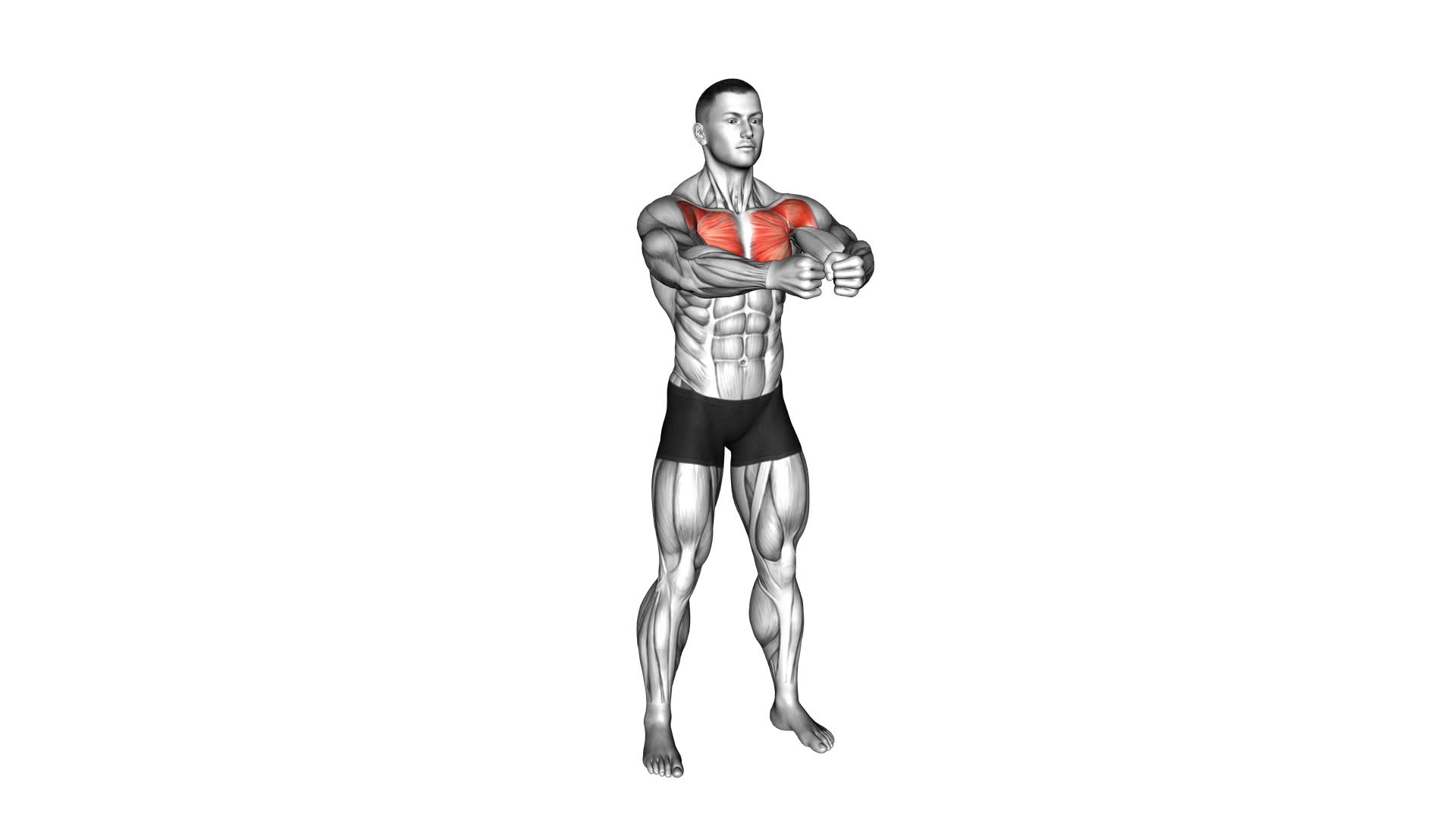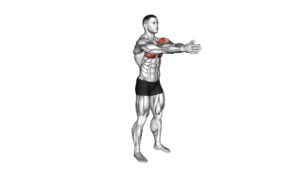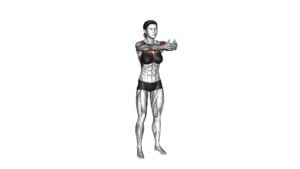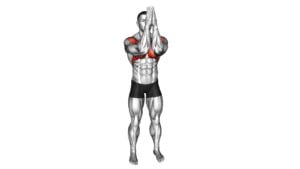Bodyweight Standing Alternate Chest Fly (male) – Video Exercise Guide & Tips

Looking to strengthen your chest muscles? Check out this video exercise guide and tips for the Bodyweight Standing Alternate Chest Fly. This exercise offers a range of benefits, including improved upper body strength and stability.
Watch This Exercise Video
Learn the proper form and technique to maximize your results, and explore variations and progressions to challenge yourself. Avoid common mistakes and get valuable tips for incorporating this exercise into your workout routine.
Get ready to level up your chest workout with this effective bodyweight exercise.
Key Takeaways
- The Bodyweight Standing Alternate Chest Fly is an effective exercise for strengthening chest muscles and improving upper body strength.
- Proper form and technique are important for maximizing the benefits of bodyweight chest exercises, including maintaining a straight line from head to heels and engaging core muscles.
- There are various variations of bodyweight chest exercises, such as push-ups, decline push-ups, wide push-ups, diamond push-ups, and plyometric push-ups, that can be incorporated to target different muscle groups.
- To maximize the effectiveness of bodyweight chest exercises, it is important to focus on mind-muscle connection, gradually increase the number of repetitions and sets, incorporate different tempos, rest adequately between sets, and combine bodyweight chest exercises with other upper body movements.
Benefits of the Bodyweight Standing Alternate Chest Fly
Discover the many benefits of incorporating the bodyweight standing alternate chest fly into your workout routine. This exercise offers several advantages that can enhance your chest training and overall fitness goals.
One of the main benefits is the muscle activation it provides. By using your own bodyweight as resistance, the standing alternate chest fly targets the pectoral muscles, specifically the major and minor muscles, as well as the anterior deltoids and triceps. This exercise helps to strengthen and tone these muscle groups, leading to improved upper body strength and definition.
Additionally, the bodyweight standing alternate chest fly engages your core muscles, promoting stability and balance. This exercise can also be modified to target different areas of the chest by adjusting the angle of your arms.
By incorporating the bodyweight standing alternate chest fly into your workout routine, you can reap the benefits of increased muscle activation and overall upper body strength.
Now, let's move on to discussing the proper form and technique for this exercise.
Proper Form and Technique for the Exercise
To perform the bodyweight standing alternate chest fly exercise with proper form and technique, begin by standing upright with your feet shoulder-width apart. This exercise is great for improving stability and targeting multiple muscle groups in your chest, shoulders, and arms.
Start by extending your arms out to your sides at shoulder height, palms facing forward. Keep your elbows slightly bent throughout the exercise to prevent strain on your joints. Engage your core and maintain a slight bend in your knees to stabilize your body.
Next, slowly bring one arm forward, crossing it in front of your body towards the opposite side. Imagine hugging a tree as you bring your arm across. Keep your chest lifted and your shoulders down and relaxed. Pause briefly at the end of the movement, feeling the stretch in your chest.
Return your arm back to the starting position and repeat the movement with the other arm. Alternate between the left and right sides for the desired number of repetitions.
Remember to breathe steadily throughout the exercise and focus on maintaining proper form. As you become more comfortable with the bodyweight standing alternate chest fly, you can explore variations and progressions to challenge yourself further.
Variations and Progressions to Challenge Yourself
To challenge yourself further and continue improving your stability and targeting multiple muscle groups, you can explore variations and progressions of the bodyweight standing alternate chest fly exercise.
One way to add intensity to this exercise is by incorporating weighted variations. By holding dumbbells or resistance bands in each hand, you increase the resistance on your chest muscles, making them work harder. Start with lighter weights and gradually increase as you build strength and confidence.
Another advanced progression you can try is the single-arm bodyweight standing alternate chest fly. Instead of using both arms simultaneously, perform the exercise with just one arm at a time. This variation requires more core stability and balance, as you have to control the movement with just one arm while maintaining proper form.
You can also experiment with different angles to target specific areas of your chest. For example, performing the exercise on an incline bench will emphasize the upper chest muscles, while doing it on a decline bench will engage the lower chest muscles more.
Remember to always maintain proper form and technique, and listen to your body. If a variation feels too challenging or causes discomfort, regress to a less advanced version until you feel ready to progress again.
Keep pushing yourself, and you'll continue to see improvements in your strength and muscle development.
Common Mistakes to Avoid During the Exercise
To ensure proper form and maximize the effectiveness of the bodyweight standing alternate chest fly exercise, it's important to avoid common mistakes.
One common mistake to avoid is improper breathing. Many people hold their breath during the exercise, which can lead to a decrease in oxygen supply to the muscles and reduce muscle activation. To avoid this, make sure to breathe in as you lower your arms and breathe out as you bring them back up. This will help you maintain a steady flow of oxygen to your muscles, allowing for optimal performance and muscle activation.
Another mistake to avoid isn't activating the correct muscles. The bodyweight standing alternate chest fly primarily targets the chest muscles, so it's important to focus on engaging these muscles throughout the exercise. Make sure to keep your chest up, shoulders back, and squeeze your chest muscles as you bring your arms forward. This will ensure that you're effectively targeting and activating the chest muscles, leading to better results.
Tips for Incorporating the Bodyweight Standing Alternate Chest Fly Into Your Workout Routine
Incorporate the bodyweight standing alternate chest fly into your workout routine by adding it as a challenging chest exercise. Here are some tips to help you effectively incorporate this exercise into your routine:
- Start with proper form: Stand with your feet shoulder-width apart, knees slightly bent, and core engaged. Hold your arms out to the sides at shoulder height, palms facing forward.
- Focus on the movement: Slowly bring one arm across your body, squeezing your chest muscles as you do so. Return to the starting position and repeat with the other arm. Keep your movements controlled and avoid using momentum.
- Gradually increase intensity: As you become more comfortable with the exercise, you can increase the challenge by using resistance bands or adding weights. This will help you build strength and muscle in your chest.
By incorporating bodyweight exercises like the standing alternate chest fly into your workout routine, you can add variety and target different muscle groups. These exercises can also be a great alternative to traditional chest exercises that require equipment.
Remember to always listen to your body and consult with a fitness professional if you have any concerns or questions.
Frequently Asked Questions
What Are the Primary Muscles Targeted by the Bodyweight Standing Alternate Chest Fly Exercise?
The primary muscles targeted by the bodyweight standing alternate chest fly exercise are the pectoralis major and minor, as well as the deltoids.
This exercise helps to strengthen and tone your chest and shoulder muscles.
By performing this exercise, you can improve your upper body strength and enhance your overall physique.
Incorporating the bodyweight standing alternate chest fly into your workout routine can be a great way to target these specific muscle groups.
How Does the Bodyweight Standing Alternate Chest Fly Differ From Traditional Dumbbell Chest Fly Exercises?
The bodyweight standing alternate chest fly differs from traditional dumbbell chest fly exercises in a few ways.
Firstly, instead of using dumbbells, you're using your own body weight as resistance. This can be beneficial if you have shoulder or back injuries as it reduces the strain on those areas.
Secondly, the tempo or speed of the exercise can be adjusted to increase or decrease the intensity.
Lastly, the frequency of including the bodyweight standing alternate chest fly in your workout routine will depend on your goals and current fitness level.
Can the Bodyweight Standing Alternate Chest Fly Be Modified for Individuals With Shoulder or Back Injuries?
Modifications for shoulder or back injuries can be made to the bodyweight standing alternate chest fly. This exercise allows you to work your chest muscles without putting too much strain on your shoulders or back. By adjusting the range of motion and using lighter resistance, you can still reap the benefits of incorporating bodyweight exercises into your routine.
Remember to listen to your body and consult with a professional if you have any concerns or limitations.
Is It Necessary to Perform the Exercise Using a Specific Tempo or Speed?
When performing the bodyweight standing alternate chest fly, it's important to maintain a specific tempo or speed. This helps ensure that you're engaging the target muscles effectively and getting the most out of the exercise.
Different variations of the exercise may require different tempos, so it's essential to follow proper form and technique.
Common mistakes to avoid include rushing through the movement or using momentum to lift the weights. Take your time and focus on the quality of each repetition.
How Frequently Should the Bodyweight Standing Alternate Chest Fly Be Included in a Workout Routine for Optimal Results?
To get optimal results with the bodyweight standing alternate chest fly, it's important to include it in your workout routine with the right frequency. By incorporating this exercise regularly into your routine, you can target and strengthen your chest muscles effectively.
However, the exact frequency will depend on your individual fitness goals and overall workout plan. Consulting with a fitness professional can help you determine the ideal frequency for incorporating this exercise into your routine.
Conclusion
Incorporating the bodyweight standing alternate chest fly into your workout routine is a great way to target and strengthen your chest muscles. By following proper form and technique, you can maximize the benefits of this exercise.
Remember to avoid common mistakes and challenge yourself with variations and progressions.
With dedication and consistency, you can achieve your fitness goals and improve your overall upper body strength.

Author
Years ago, the spark of my life’s passion ignited in my mind the moment I stepped into the local gym for the first time. The inaugural bead of perspiration, the initial endeavor, the very first surge of endorphins, and a sense of pride that washed over me post-workout marked the beginning of my deep-seated interest in strength sports, fitness, and sports nutrition. This very curiosity blossomed rapidly into a profound fascination, propelling me to earn a Master’s degree in Physical Education from the Academy of Physical Education in Krakow, followed by a Sports Manager diploma from the Jagiellonian University. My journey of growth led me to gain more specialized qualifications, such as being a certified personal trainer with a focus on sports dietetics, a lifeguard, and an instructor for wellness and corrective gymnastics. Theoretical knowledge paired seamlessly with practical experience, reinforcing my belief that the transformation of individuals under my guidance was also a reflection of my personal growth. This belief holds true even today. Each day, I strive to push the boundaries and explore new realms. These realms gently elevate me to greater heights. The unique combination of passion for my field and the continuous quest for growth fuels my drive to break new ground.







